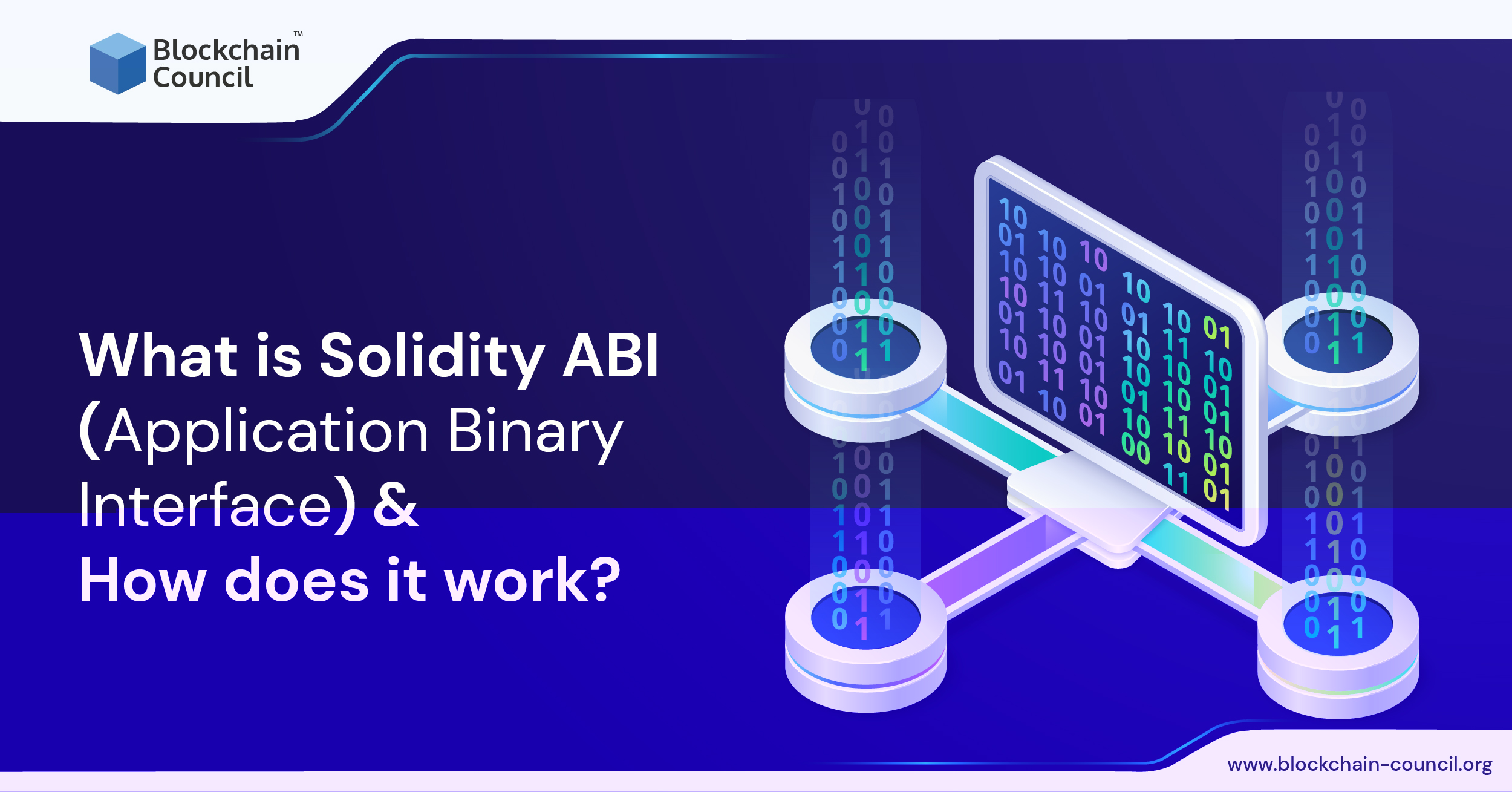
- Blockchain Council
- November 08, 2022
Solidity has recently become popular. Developers use the programming language to construct smart contracts for decentralized applications. On the Ethereum blockchain, Solidity is a favored programming language for building smart contracts, and it ranks among the top programming languages relied upon by web3 and blockchain newcomers.
Solidity ABI, or Application Binary Interface, is one of the significant concepts linked with the language required to ensure its functionality. Are you familiar with the operations of the Solidity ABI? Do you want to learn why Solidity programming language includes it as a core component?
The following blog provides an in-depth discussion of how ABI in Solidity functions. We will also provide explicit arguments as to why the Application Binary Interface is essential to interact within the Ethereum ecosystem.
Get to know more about Ethereum development. Enroll in our Ethereum Developer certification today!
Understanding ABI
Writing smart contract code for the Ethereum network necessitates the usage of the Solidity programming language and is widely used by Ethereum developers. But how do the Ethereum Virtual Machine (EVM) and Solidity interact?
Simply put, Solidity acts as the arbitrator between us and the EVM and is used to smart code contracts.
In computer science, an ABI (Application Binary Interface) interface between two software modules, most commonly between user programs and operating systems. Solidity is a high-level programming language based on this and is used exclusively by developers to create comprehensible smart contracts.
Solidity, though, is incomprehensible to the EVM. Compilation changes Solidity’s human-readable code into a language the virtual machine can understand because Solidity is not a language that the virtual machine can understand. The smart contracts in the Ethereum blockchain-based ecosystem are built on the Solidity compiler.
The EVM executes smart contracts, which are code fragments stored on the blockchain. It also offers a comprehensive collection of instructions known as opcodes, which carry out particular commands. These are fundamental codes that resemble the instruction set of a processor. The Ethereum Yellow Paper contains links to the most popular Ethereum opcodes.
The Ethereum blockchain stores the complete software as a form of address and hash value in the form of bytes or binary representation. The contracts in the context of Ethereum and the EVM are nothing more than single programs that execute on this set of bytes. How to get from the program’s entrance point to a specific function’s entry point is only defined by higher-level languages like Viper, Bamboo, or Solidity.
When another smart contract or an external application wishes to communicate with the blockchain, it requires some understanding of the interface of a smart contract, such as the ability to recognize a method and its inputs. The Ethereum Application Binary Interface (ABI) facilitates this.
Learn more about Ethereum smart-contract development. Enroll in our Solidity Developer today!
API vs. ABI
Application Program Interface (API), simply a representation of the code’s interface in human-readable form or a high-level language, is comparable. In the EVM, compiled code is saved as binary data, human-readable interfaces are removed, and smart contract interactions are converted into a binary format that the EVM can understand. ABI defines, at a lower level than the API, the methods and structures that you may use to interact with that binary contract easily.
ABI Encoding
The ABI informs the caller of the information (variable declarations and function signatures) that must be encoded so that the Virtual Machine can understand the byte code (contract). This method is known as ABI encoding.
The ABI then connects two program modules, one of which is primarily at the machine code level. The interface is employed by default for encoding or decoding data into or out of machine code. It comes down to how you encode a language in Ethereum so that contracts may call the EVM or how to read data out of transactions.
ABI encoding is carried out automatically by tools built within the compiler, such as REMIX, or by wallets that can communicate with the blockchain. A description of the contract’s interface, including the function name and parameters, is required by the ABI encoder and is frequently supplied as a JSON file.
Want to comprehend Solidity principles in great detail? Join today for free access to the Solidity Fundamentals Course!
Understanding the elements of ABI
An ABI speculates the function to call (encoding) and runs the function to provide user data(decoding). For every smart contract, an individual ABI is necessary to obtain the results. A smart contract consists of numerous functions sent on the EVM in the form of bytecode.
Inherently, the ABI simply describes the methods and structures for interacting with binary contracts because smart contracts are stored in binary format. A post-compilation smart contract creates an ABI represented in Solidity JSON ABI format.
Some IDEs, such as REMIX, generate the contract ABI automatically. Using the Solidity Compiler NPM package, you can also manually construct the ABI.
Different event descriptions and functions provide the JSON format of an ABI for a contract. The components that can be found in an ABI function description are as below:
- Type – describes the function’s nature (fallback, receive, constructor)
- Name – specifies the function’s name.
- Inputs – an array of items with types, names, and components
- Output – an array of items comparable to inputs
- State Mutability- The definition of mutability for a function (view, pure, payable, or non-payable)
Working on transactions with an ABI
A transaction with a Solidity ABI file operates in three steps:
- A front-end library like EtherJS is given access to a smart contract’s ABI.
- The method call and parameters are converted into call data by the frontend library and sent to an Ethereum node as part of a transaction.
- Following the validation of a transaction, a trie comprising receipts of the specific logs and gas (transaction fees) used is generated.
Functioning of an ABI – Step-by-step,
An overview of the various stages of how an ABI transaction operates on Solidity, can be found below:
- Frontend libraries like EtherJS are given access to the smart contract ABI.
- Once the method call and arguments have been translated into call data, which must be provided to an Ethereum node as a transaction, the frontend library will begin its work.
- After the transaction has been verified, a receipts trie with a thorough breakdown of the transaction logs and costs incurred is created.
Detailed functioning of ABI
Without considering how they function, this Solidity Application Binary Interfaces tutorial would be lacking.
Oddly enough, given the specifics of the smart contract compilation process, you must have gleaned a fundamental understanding of how ABIs operate. Let’s review the steps and key elements that led to establishing the application binary interfaces.
- Compiling smart contracts would be the first and most crucial stage in ensuring Solidity’s functionality. The compilation transforms the machine-readable Ethereum Virtual Machine code from the smart contract code in Solidity.
- Because the EVM cannot comprehend Solidity computer code, smart contracts must be processed via the Solidity Compiler. It is crucial to remember that the compiler, also known as solc, works with ABI to build Solidity smart contracts into EVM-compatible code. This provides a clear picture of the origins of ABIs.
- When the compilation process is complete, the EVM will contain the bytecode-covered smart contract code. On the other side, the smart contract code is written in the Solidity programming language for external apps and other smart contracts. ABI is afterward one of the key elements linked to Solidity-based smart contract processes.
- ABI is an interpreter for external programs and smart contracts to facilitate communication with EVM. Several smart contract methods for enabling access to particular functions are included in the Solidity Application Binary Interface, which is human-readable. Programmers can integrate the ABI with other libraries, such as Ethers.js, to allow interactions with smart contracts.
Solidity Binaries
Binaries are considered to be the most crucial element in how ABIs operate. The unique method used by the Ethereum ecosystem to store the data used in smart contracts is known as “Solidity Binaries.” The Ethereum network does not directly support developers using the human-readable Solidity smart contract code. The binaries enable cost-effective data storage on the all-new blockchain technology. You need to be more familiar with Solidity’s ABI encoding and decoding for more in-depth originality.
Conclusion
You will learn more about ABI as you study Solidity, the foundation of Ethereum smart contracts. In the blockchain ecosystem, ABIs make transactions easier. ABIs are frequently ignored in developer tutorials despite the significance of ABIs in smart contract technologies. Even though it is outside the purview of this tutorial, being familiar with the Solidity interface can help you better grasp how contracts interact.
The first step to creating reliable smart contracts and dApps and being a Solidity developer is to thoroughly understand ABI.
If you want to keep up with the trends of blockchain industry, join our communities on Discord, Reddit and Telegram.




































































 Guides
Guides News
News Blockchain
Blockchain Cryptocurrency
& Digital Assets
Cryptocurrency
& Digital Assets Web3
Web3 Metaverse & NFTs
Metaverse & NFTs
